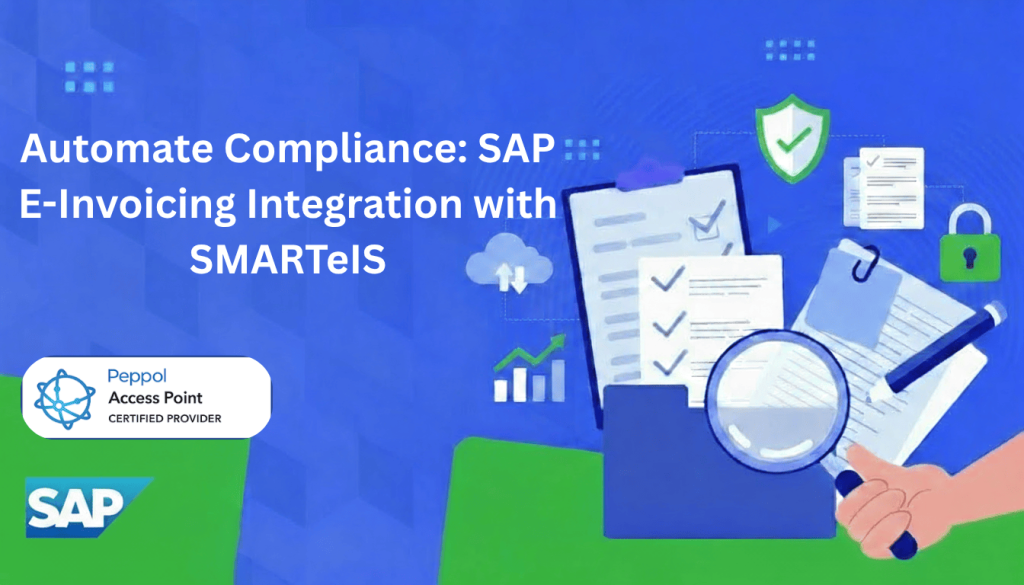SAP E-Invoicing UAE: Integration, Compliance & Implementation Guide

The UAE’s Federal Tax Authority (FTA) e-invoicing mandate represents more than a compliance checkbox for SAP users. For organizations running SAP ECC or S/4HANA, the challenge isn’t understanding regulatory requirements—it’s navigating the architectural decisions, data quality issues, and performance bottlenecks that emerge when connecting legacy ERP systems to real-time government validation platforms.
This guide draws from real-world implementations as an FTA pre-approved e-invoicing provider, addressing the technical challenges SAP professionals face during compliance projects.
SAP E-Invoicing Integration Architecture: Choosing the Right Approach
One of the most critical decisions in any SAP e-invoicing UAE project is determining where the e-invoicing logic should reside. This architectural choice impacts performance, maintainability, and long-term scalability.
Option 1: SAP Cloud Platform Integration (CPI/PI)
Using SAP’s native middleware appears logical for organizations already invested in the SAP ecosystem. Your invoices remain within familiar territory, and your BASIS team operates within their comfort zone.
The challenge? Latency. When the FTA requires sub-second response times, CPI introduces additional hops that become problematic during peak periods. During month-end closings with 5,000+ invoices queuing simultaneously, timeout issues frequently emerge.
Option 2: Direct API Integration
Direct RESTful API connections eliminate middleware overhead and reduce latency. This offers the fastest path from invoice creation to FTA validation.
However, you’re now managing OAuth tokens in ABAP, implementing retry mechanisms, and maintaining custom RFC function modules that become maintenance liabilities during upgrades. Organizations have discovered their custom integration code breaking during S/4HANA conversion because API endpoints were hardcoded in includes not flagged during migration assessment.
Option 3: SAP Business Technology Platform (BTP) Hybrid
SAP BTP provides a middle ground—serverless functions between your core SAP system and external FTA-compliant providers. This allows modifying integration logic without touching production SAP code.
The trade-off? Another platform to monitor, secure, license, and maintain.
Option 4: Managed Integration via Pre-Approved Providers
Organizations can leverage FTA pre-approved e-invoicing platforms that handle the complexity of XML conversion, digital signing, and API connectivity. This approach reduces custom code maintenance and ensures ongoing compliance as FTA regulations evolve.
Advantages:
- Pre-built integrations for SAP ECC and S/4HANA
- Automatic schema updates when FTA requirements change
- Reduced dependency on internal ABAP resources
- Faster implementation timelines (8-12 weeks vs. 6+ months)
Considerations:
- Ongoing subscription costs
- Dependency on vendor uptime and support
- Less control over integration logic
The Right Architecture: There’s no universal answer. The optimal approach depends on transaction volume, customization depth, system landscape (ECC6, S/4HANA on-premise, or Cloud), and internal technical capabilities.
SAP Master Data Quality: The Foundation of FTA E-Invoicing Compliance
The FTA’s XML schema is unforgiving. A single missing decimal or invalid tax code triggers invoice rejection. For SAP systems carrying 15+ years of customizations, data consistency becomes the primary implementation challenge.
The Tax Code Mapping Challenge
Most SAP implementations use customized MWSK (tax codes) created over years. You might have separate codes for “Standard VAT – Trading,” “Standard VAT – Services,” and “Standard VAT – Import”—all 5% VAT but differentiated internally. The FTA’s standardized schema wants a single classification.
Creating a mapping table seems straightforward until this logic must execute for every line item on every invoice. When procurement creates new custom tax codes in MM (and they will), your e-invoicing integration starts failing—usually at 2 AM on Saturday.
Solution: Implement tax code governance at the source. Lock down creation authority, establish validation at invoice generation (not just transmission), and build automated alerting when unmapped codes appear.
Address Standardization for UAE E-Invoicing
FTA regulations require structured address data: building numbers, street names, districts in discrete fields. Your SAP customer masters contain free-text entries like “Near Dubai Mall, next to the fountain, the tall building.”
A practical implementation requires:
- Address parsing algorithms extracting structured data from free text
- Pre-validation at document creation for immediate feedback
- Automated cleanup workflows for unparseable addresses
- Partner function analysis (addresses often populate from alternate SD partner functions)
One manufacturing client spent three months cleansing 40,000 customer records, only to discover their sales orders pulled addresses from ship-to partner functions not included in initial scope.
Real-Time FTA Validation vs. SAP Batch Processing Performance
Traditional SAP invoice processing operates in batch mode—VF01/VF04 for billing, F110 for payments, scheduled jobs for outputs. You create 10,000 invoices in 30 minutes, then transmit them.
UAE e-invoicing flips this. Each invoice requires FTA validation before completion.
The Performance Impact
Synchronous validation means your billing document isn’t committed until the provider responds. Load testing revealed that real-time validation increased average billing document creation from 0.8 seconds to 3.2 seconds.
When processing 50,000 daily transactions, this 400% increase creates operational chaos.
Solutions:
- Decouple creation from finalization with “pending validation” status
- Implement priority queuing for rush orders
- Build reconciliation dashboards for visibility
- Define exception workflows for rejected invoices
SAP S/4HANA Migration and E-Invoicing Implementation Timing
If running SAP ECC6, you’re likely planning S/4HANA migration. UAE e-invoicing compliance complicates this transition. Critical question: implement before or after conversion?
Brownfield Migration Complexity
Converting existing custom e-invoicing code during brownfield migration isn’t straightforward. Custom function modules might depend on deprecated BAPIs. Z-tables might not be HANA-optimized. User exits could conflict with S/4HANA’s redesigned tax determination.
Organizations have discovered custom e-invoicing solutions—working perfectly in ECC—require complete rewrites due to document flow logic changes in S/4HANA’s new architecture.
Strategic Timing
Implement before migration: Building on a platform you’ll replace within 12-24 months means throwaway investment.
Implement after migration: Running non-compliant for months risks penalties and audit exposure.
Pragmatic approach: Implement minimal viable compliance in ECC using provider-managed solutions (reducing custom code), then re-platform properly during S/4HANA migration with lessons learned.
Multi-Company SAP E-Invoicing: UAE Free Zone Complexity
The UAE’s diverse regulatory landscape—mainland, free zones, special economic zones—each with distinct tax treatments, multiplies implementation complexity for multi-entity organizations.
Company Code and TRN Mapping
FTA registration operates per TRN (Tax Registration Number). Your SAP might have multiple company codes sharing one TRN, or one company code with multiple TRNs for different business units.
The e-invoicing provider needs to determine which TRN applies to each invoice—information often missing from standard billing document fields. This requires custom logic examining plant locations, sales organizations, or customer tax jurisdictions.
Intercompany Invoice Duplication
Intercompany transactions generate duplicate invoices—one from selling company code, another from receiving entity. Do both require FTA validation? Regulations lack explicit clarity, and providers interpret requirements differently.
One conglomerate discovered they were submitting 40% more invoices than necessary because automated processes blindly sent every billing document without filtering internal transfers.
SAP E-Invoicing Monitoring: Beyond Standard Tools
Standard SAP monitoring tools—ST22, SM21, SLG1—don’t provide adequate visibility into e-invoicing-specific failures. Production-grade implementations require dedicated monitoring showing:
- Real-time validation success/failure rates by hour and company code
- Average validation latency trending
- Failed invoice details with actual FTA error messages
- Retry queue status and aging analysis
- Provider API health metrics
This requires custom development—typically a Fiori app pulling data from custom logging tables. Without this visibility, you’re troubleshooting blind during critical periods.
Configure monitoring too aggressively and teams receive 50 daily alerts about transient timeouts. Too conservatively, and you discover thousands of failed invoices only when customers complain. Finding optimal thresholds requires weeks of production observation and continuous tuning.
Implementation Best Practices for SAP E-Invoicing in UAE
Successful FTA-compliant e-invoicing requires architectural thinking, data discipline, and realistic expectations about organizational change.
Start with data quality audits. Before integrating any provider, audit tax codes, customer addresses, and material masters. Fix the foundation first.
Design for failure. Networks fail. APIs timeout. Schemas change. Build idempotent retry logic, comprehensive error logging, and clear escalation procedures into your initial architecture.
Involve business stakeholders early. E-invoicing changes billing operations. Sales, finance, and customer service need to understand new constraints and exception processes.
Recognize compliance as the baseline. Real value emerges from leveraging real-time validation data to improve billing accuracy, reduce disputes, and accelerate cash collection. Expert SAP professionals turn regulatory burden into competitive advantage.
FAQs: SAP E-Invoicing in the UAE
The optimal integration approach depends on your specific environment. Organizations with high transaction volumes and strong ABAP capabilities often benefit from direct API integration despite higher maintenance. Companies preferring managed solutions typically choose SAP BTP or CPI, accepting some latency for reduced custom code. Many enterprises, however, find that working with FTA pre-approved providers such as SMARTeIS offers the best balance of speed, compliance assurance, and reduced technical debt — especially when seamless SAP integration and continuous schema updates are required. Match your integration architecture to your transaction volume, technical resources, and S/4HANA migration timeline.
E-invoicing compliance significantly impacts S/4HANA migration timing. Implementing in ECC6 before migration means building on a platform you’ll replace within 12-24 months. Waiting until after leaves you non-compliant during transition. The pragmatic approach involves minimal viable compliance in ECC using provider-managed solutions, then proper re-platforming during conversion using lessons learned from production.
Most frequent challenges include: unmapped custom tax codes that don’t align with FTA standardized categories, free-text address fields lacking required structured data (building number, street, district), partner function complexity where billing addresses pull from unexpected SD configuration, and tax classification inconsistencies across company codes in multi-entity landscapes.
Select providers with FTA pre-approval status, demonstrating validated compliance with technical and security requirements. Evaluate their SAP integration experience, particularly with your specific landscape (ECC6 or S/4HANA), real-time validation performance under load, and track record managing schema updates as regulations evolve. Pre-approved status indicates the solution has been tested against FTA’s standards.
Timeline varies based on data quality, customization complexity, and integration approach. Organizations with clean master data and minimal custom code can achieve basic compliance in 8-12 weeks. Enterprises with heavily customized SAP systems, multiple company codes, and significant data quality issues typically require 4-6 months for full production readiness including user training and stabilization.
E-invoicing touches multiple modules: SD (Sales & Distribution) for billing document creation and output determination, FI (Financial Accounting) for tax determination and posting logic, MM (Materials Management) for vendor invoice processing, and custom ABAP development for API connectivity, data transformation, and error handling workflows.
Conclusion: Streamline SAP E-Invoicing with SMARTeIS
The technical decisions you make today in your SAP e-invoicing UAE implementation will impact operations for years. Choose architecture over shortcuts, invest in comprehensive monitoring over optimistic assumptions, and treat this as fundamental business process redesign—not just an IT compliance project.
By integrating with an FTA-compliant solution like SMARTeIS, your business can:
✅ Automate invoice creation and submission
✅ Ensure real-time FTA validation
✅ Reduce manual effort and errors
✅ Achieve full audit and regulatory compliance
👉 Learn more at https://smart-einvoicing.com
